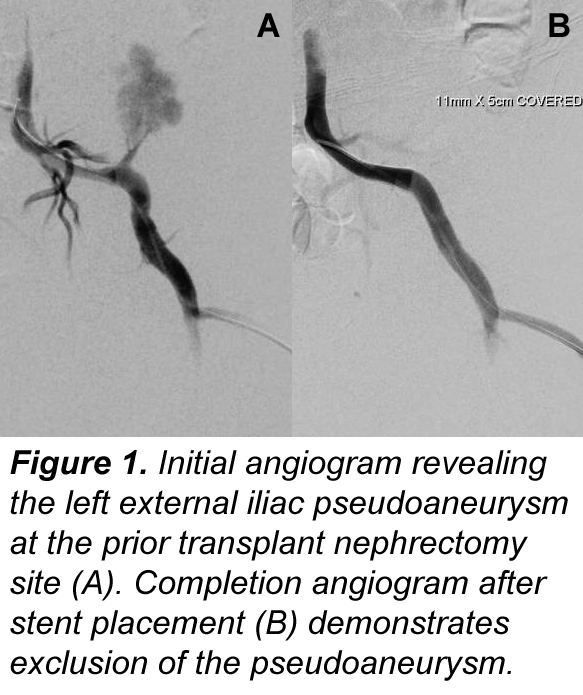Back to 2016 Annual Symposium ePosters
Endovascular Stenting via Arteriovenous Graft for External Iliac Artery Pseudoaneurysm After Transplant Nephrectomy
Cindy Huynh, MD, Shilpa Agarwal, BS, Vivian Gahtan, MD, Michael J. Costanza, MD.
SUNY Upstate Medical University, Syracuse, NY, USA.
OBJECTIVE: Despite new advances in immunosuppressive therapy and decreasing acute rejection rates, long-term renal allograft survival has not significantly improved. Transplant nephrectomy after failed transplant is associated with high morbidity and mortality due to immunosuppression, patient comorbidities, and technical difficulty. Complications include infection, hemorrhage, and, rarely, external iliac artery pseudoaneurysm at the previous renal transplant anastomotic site. Options for repair include open surgery often involving ligating the external iliac artery or less invasive endovascular procedures. We present a patient with a symptomatic left external iliac artery pseudoaneurysm after transplant nephrectomy that was treated with endovascular stent placement using her ipsilateral femoral arteriovenous graft for vascular access.
METHODS: A 27-year-old woman with a history of hemolytic uremic syndrome, end-stage renal disease, and 2 transplant nephrectomies due to graft failure, presented several years later with left lower quadrant abdominal pain. Her exam demonstrated a large, pulsatile abdominal mass and a functional left femoral arteriovenous dialysis access graft. CT imaging showed a 5cm pseudoaneurysm originating from the left external iliac artery.
RESULTS: After accessing the left femoral arteriovenous graft in the direction of the arterial anastomosis, intravascular ultrasound (IVUS) was used to accurately measure the diameter of the left external iliac artery proximal and distal to the pseudoaneurysm. An 11mm diameter x 5cm length Viabahn stent graft (Gore, Flagstaff, AZ) was placed to exclude the pseudoaneurysm (figure 1). Her transplant surgeon later evacuated the pseudoaneurysm and the cultures showed no signs of infection. On three-year follow up, CT imaging showed a patent left external iliac artery stent graft with a completely excluded, small residual pseudoaneurysm cavity.
CONCLUSIONS: External iliac artery pseudoaneurysm is a rare complication following transplant nephrectomy. To our knowledge, this is the first reported stent graft repair of an external iliac artery pseudoaneurysm after transplant nephrectomy using an ipsilateral femoral arteriovenous graft for arterial access. An endovascular approach offers a safe and minimally invasive technique for external iliac artery pseudoaneurysms. The major drawback to this approach is the loss of the stented external iliac artery as a potential site for a future renal transplant.

Back to 2016 Annual Symposium ePosters
|







